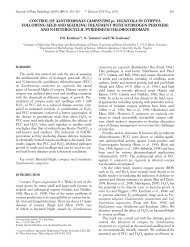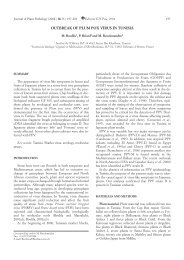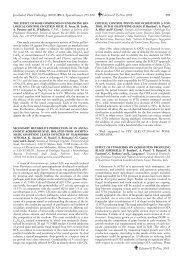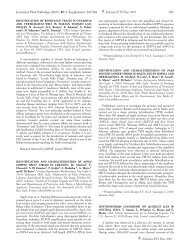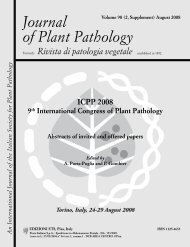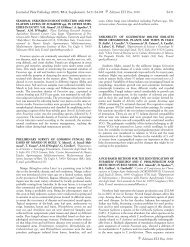Journal of Plant Pathology - Sipav.org
Journal of Plant Pathology - Sipav.org
Journal of Plant Pathology - Sipav.org
You also want an ePaper? Increase the reach of your titles
YUMPU automatically turns print PDFs into web optimized ePapers that Google loves.
<strong>Journal</strong> <strong>of</strong> <strong>Plant</strong> <strong>Pathology</strong> (2011), 93 (1, Supplement), S1.15-S1.18 Edizioni ETS Pisa, 2011 S1.15<br />
TIMELY FUNGICIDE APPLICATION: A STRATEGY TO MINIMIZE<br />
FUSARIUM HEAD BLIGHT AND ASSOCIATED MYCOTOXIN PRODUCTION<br />
IN WINTER WHEAT<br />
F. Giraud 1 , M. Pasquali 2 , M. El Jarroudi 3 , M. Cocco 2 , P. Delfosse 2 , L. H<strong>of</strong>fmann 2 and T. Bohn 2<br />
1<br />
Laboratoire BIORIZON (STAPHYT Groupe), Rue Magendie/Site Bordeaux Montesquieu, 33650 Martillac, France<br />
2<br />
Centre de Recherche Public-Gabriel Lippmann, Département Environnement et Agro-biotechnologies (EVA),<br />
41, Rue du Brill, 4422 Belvaux, Luxembourg<br />
3<br />
Departement des Sciences et de Gestion de l’Environnement, Université de Liège, 6700 Arlon, Belgium<br />
SUMMARY<br />
Re-emergence <strong>of</strong> Fusarium head blight (FHB) on<br />
wheat should be taken into account in the global management<br />
<strong>of</strong> cropped fields, especially with respect to<br />
fungicide application schemes, due to harmful toxin<br />
production. The aim <strong>of</strong> this study was to assess, in three<br />
experimental fields representative <strong>of</strong> the various<br />
topoclimatological zones <strong>of</strong> Luxembourg, the impact <strong>of</strong><br />
timing <strong>of</strong> fungicide spray application on the prevalence<br />
and severity <strong>of</strong> FHB, the concentration <strong>of</strong> mycotoxins,<br />
and Fusarium strain pattern in winter wheat. It was<br />
found that fungicide treatments and the time <strong>of</strong> application<br />
had a significant impact on the amount <strong>of</strong> deoxynivalenol<br />
(DON) detected (P=0.027, ANOVA). In our experimental<br />
design, the application <strong>of</strong> fungicides at 3 different<br />
times increased the amount <strong>of</strong> DON in winter<br />
wheat compared to two and single applications. The importance<br />
<strong>of</strong> the timing <strong>of</strong> fungicide application is discussed<br />
in relation to limiting toxin contamination in the<br />
field.<br />
Key words: Fusarium spp., deoxynivalenol, cereals,<br />
chemical treatments<br />
INTRODUCTION<br />
Corresponding author: F. Giraud and T. Bohn<br />
Fax: +33.557960601; +352.470264<br />
E-mail: fgiraud@staphyt.fr; bohn@lippmann.lu<br />
Fungi <strong>of</strong> the genus Fusarium are <strong>of</strong> great economic<br />
significance due to their widespread occurrence and<br />
high pathogenicity to all crop species grown throughout<br />
the world. Fusarium head blight (FHB), mainly caused<br />
by Fusarium avenaceum, F. culmorum, F. graminearum,<br />
and F. poae can be devastating, with an overall decrease<br />
in yield reaching 70%. In addition, toxic secondary<br />
metabolites produced by Fusarium species can be present<br />
in contaminated FHB-affected grain (Bullerman and<br />
Bianchini, 2007; Dexter et al., 1997; Pirgozliev et al.,<br />
2003). The most common among them are trichotecenes,<br />
mostly <strong>of</strong> type B, which include deoxynivalenol<br />
(DON), nivalenol (NIV)) and zearalenone<br />
(ZON). The above substances exhibit very strong phytotoxic<br />
and zootoxic effects (Gutleb et al., 2002; Rotter<br />
et al., 1996; Minervini et al., 2004).<br />
FHB has been increasing in incidence and severity in<br />
recent years, due to the implementation <strong>of</strong> simplified<br />
crop rotation (in particular with respect to wheat and<br />
maize production) and the lack <strong>of</strong> effective fungicide<br />
control for Fusarium, thus resulting in the development<br />
<strong>of</strong> resistant strains and the absence <strong>of</strong> crop varieties resistant<br />
to the disease.<br />
Fungicide control <strong>of</strong> FHB has proved non-constant,<br />
and conflicting evidence exists regarding the effect <strong>of</strong><br />
mycotoxin accumulation in grains contaminated by<br />
Fusarium spp. (Pirgozliev et al., 2002). Previous studies<br />
from Luxembourg showed that type B trichothecene<br />
contamination frequently occurrs in winter wheat (Giraud<br />
et al., 2010) and could be predicted by genetic<br />
chemotyping (Pasquali et al., 2010).<br />
The aim <strong>of</strong> the present study was to assess the impact<br />
<strong>of</strong> the time <strong>of</strong> fungicide spray application on the concentration<br />
<strong>of</strong> mycotoxins in winter wheat, i.e. in the<br />
grains at harvest time. Efficacy <strong>of</strong> fungicide treatments<br />
as measured by FHB prevalence and the occurrence <strong>of</strong><br />
Fusarium mycotoxins were assessed in three experimental<br />
fields. In addition, changes in Fusarium population<br />
composition were investigated by morphological and<br />
molecular methods.<br />
MATERIAL AND METHODS<br />
Three fungicide treatments were tested in each <strong>of</strong><br />
three experimental sites (Burmerange, Reuler and<br />
Christnach), representative <strong>of</strong> the three topoclimatological<br />
zones <strong>of</strong> Luxembourg (south, north and center, respectively).<br />
Treatments were assigned to experimental units, using<br />
a randomized complete block split-plot design with<br />
four replications for each sub-plot (each site was composed<br />
<strong>of</strong> 16 experimental units). Each sub-plot was 12<br />
m 2 in size and wheat was harvested in early to mid-July<br />
at the southern site (Burmerange) and at the beginning<br />
<strong>of</strong> August at the northern site (Reuler), with a cereal



